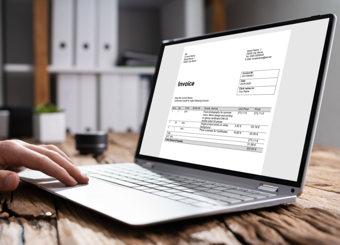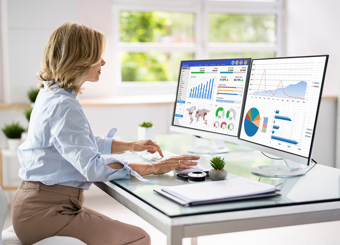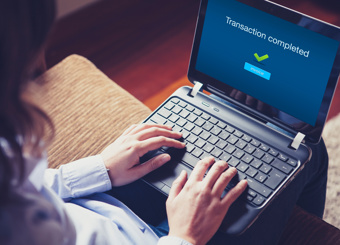The ultimate guide to working from home during the COVID-19 pandemic
Over the last two weeks, the COVID-19 virus has spread across the globe. Now, there are thousands of new cases every single day, with social distancing measures being introduced at a breakneck pace. Of these, for those that are capable, working from home has become mandatory.
You may have worked from home on an odd day in the past, but it's likely that you’re going to have to work remotely for an extended period as the world navigates its way through this crisis. Like many other companies, Medius has asked many of our employees to work remotely and we’ve issued them with tips and advice on how to work productively, comfortably, and safely from home. We share these insights in this blog post.
Maintain your morning routine

Perhaps one of the most important things you can do is maintain your existing routine according to Per Åkerberg, CEO and President of Medius.
“You should try to get up at the usual time and go through your usual morning rituals to get yourself ready to work for the day. So, if that means working out and then having a shower before heading to work, do that.
“Or, if it’s having breakfast with your kids and getting them ready for school, do that too. It’s important to maintain these habits as humans crave routine and structure.”
Keeping your routine will help you prepare yourself for your workday, but it’ll also help you retain some sense of normality during these unprecedented times.
Evaluate your space

Take a few moments to evaluate your home and to find a spot where it’d be ideal to work from home. Ideally, you’d want somewhere quiet, away from children, pets and other distractions. If you’ve got a spare room, try to use that as your working space.
If not, consider setting yourself in a quiet area of your living room, dining room or bedroom can work; so long as it’s away from distractions and other people.
It’s important, when you’re picking your workstation location, that it allows you to separate your home life from your work life. So, a big no-no is working sprawled across your living room sofa or in your bed; because let’s face it, your productivity will take a big hit!
Also, try to ensure that where you work has plenty of natural light, it’ll help improve your mood, but give your space a better look and feel to it.
Make sure that when you’re working, people know to stay out of your way as you concentrate on getting things done, otherwise you might end up like Professor Robert Kelly, in the now-infamous video clip!
Desk or no desk?
If you’ve got the cash and space, you should consider getting yourself a desk and chair. It’ll help you maintain the correct posture as you work from home and save an expensive trip to the chiropractor. But what sort of desk works best? Here are some key considerations from Hanne Engberg, Vice President of HR at Medius.
- Size does matter – make sure you’ve clearly measured out space where your desk is going to go, because the last thing you’ll want is a desk that doesn’t fit in its designated spot. We’d advise trying to get as big a desk as reasonable, to give you space to place your equipment, notepad, and other things you’d usually have on your desk in the office
- Consider style – just because it’s your home desk, it doesn’t mean you can’t make it stylish! Consider your décor and whether the desk you want will fit in your space or not. Space-saving corner desks can be stylish and fit a suite of equipment on it
- Get an appropriate chair – once you’ve bought an appropriate desk, you should consider spending more on a seat for you to do your work. Those that offer lumbar support and armrests are best to ensure you sit upright and keep your back straight. You’ll want to make sure your chair is adjustable so you can raise or lower the seat to sit right at your desk.
- Consider taking the DSE online assessment – in the UK it’s a legal requirement for your employer to provide everything you need to work remotely without compromising your physical health. Take the online DSE assessment to determine whether your workspace is compliant and to understand what your employer needs to do to make it compliant.
The equipment you’ll need

Now you’ve got your desk and chair sorted, it’s time to put stuff on it. At the very least, your organization will have provided you with a computer – whether it’s a desktop or laptop.
Now, you’ll want to ensure you’ve got the right kit to go with it, and Sean McCarrol, Head of IT Services at Medius has some advice for you:
“First, you’ll want to make sure you’ve got an appropriate monitor for your setup. Typical monitor sizes include 24-inch Full HD screens, and you can buy a pair of them to boost your productivity. But if you’ve got extra cash to spend, you could go for a Quad HD (QHD) screen, which offers a much crisper picture.
“If you go for QHD, you’ll need to get at least a 27-inch monitor to enjoy its benefits.”
Besides a monitor, there are other equipment home workers should consider purchasing. For desktop users, a keyboard and mouse are mandatory, but it’s also extremely useful for those using laptops. McCarrol explains why: “Laptops are bad ergonomically for extended use, so you could end up with sore wrists or arms as you continue to work from it over the coming weeks. You’ll want to get hold of a proper, full-size keyboard and mouse too.”
Finally, Sean recommends getting a decent webcam and a pair of headphones, because you’ll likely be conferencing a lot if you’re working from home.
“Invest in a webcam that’s full-HD to make sure that people you communicate with can you see you clearly, instead of on some crummy sub-par device. In addition, while built-in microphones on laptops have improved in the last few years, you’ll still want to consider buying a headset with a microphone to ensure you can hear your colleagues and to eliminate feedback from your in-built laptop speakers.”
Effectively communicating and managing your team

You’ve got a fantastic team around you except they’re, physically, not around you anymore - they’re all at home themselves. Managing people remotely is something you’re going to have to learn quickly to ensure your staff remain motivated and productive in the coming weeks and months. Jenny Gruvfält, Director of Marketing Communications at Medius shares her top tips for managing remote employees:
#1 – Get personal with your team
Managing employees remotely requires forging deep and personal relationships just like you would with an office-based employee. So, dedicate a slot of time to get to talk to your staff, see how they are and whether they need any help with anything. You want to strike a balance between ensuring your employee knows you’re there to help, but also not be too overbearing to the point of micromanaging them. Your listening, communication, and intuition skills are key.
#2 – Make use of technology
Strongly encourage the use of video calls whenever possible and really encourage your team to flick their webcam on. Your colleagues won’t be able to see people regularly, so seeing your colleagues every day will help keep morale up. Video conferencing tools like Microsoft Teams, Zoom, BlueJeans, and others are instrumental here, so make sure you use them. In addition, using instant messaging tools such as Google Chat, Slack, or again Microsoft Teams, can replace the water cooler conversation you’d typically have in the office, so encourage the use of that platform too.
#3 – But don’t forget your phone too
If your employee doesn’t have a webcam, don’t forget to use your phone! A quick phone call or text message to check in how your member of staff is feeling goes a long way to boosting morale.
Most mobile phones have selfie cameras on them too, so if their webcam doesn’t work for whatever reason, you can use these devices to initiate that important face-to-face communication.
#4 – Hold your team accountable
Treat working remotely as you would working from the office. So, that involves ensuring your team has an appropriate workload and are executing on it accordingly. Make sure to check in regularly to ensure they’re coping with the work they're assigned and to outline your expectations for continued productivity.
It’s a fine line between checking in and making sure your team is continuing to be productive, but not to micromanage, so use your instincts here.
#5 – Reassure your team
It’s difficult to gauge how remote employees are feeling when you don’t see them every single day. Right now, anxiety levels are going to be quite high, so do what you can as a leader to allay them. Check-in your staff and let them know you value them, their work, and just generally asking them how they’re doing is a successful stress management strategy.
Essential workplace exercises

Working for 40 hours a week – or sometimes more – and all the other things you need to do in your life, leaves very little time to keep yourself fit.
But working from home takes its toll on your body. As hunter-gatherers, we’re not designed to sit at our desks, kitchen tables, or other spaces for eight hours a day. It causes your leg and glute muscles to weaken and waste away, as well as promoting poor circulation – which could lead to swollen ankles, deep vein thrombosis, and myriad other medical conditions.
The lack of activity, when sat at your desk, doesn’t just affect your body, it can also affect your mind. According to research by the American College of Sports and Medicine, 60% of employees reported their time management, mental performance, and ability to meet deadlines improved on the days they exercised.
Here are several exercises to help your body and wellbeing in the workplace – and you can do all of them at your desk!
#1 – Seated leg raises
This exercise can be done when you’re in a meeting without people noticing. Here are the steps:
- Sit upright in your chair
- Straighten your left leg so it’s in line with the floor and hold it for ten seconds
- Repeat this same process with your right leg
- Continue this process for 15 repetitions
- For an extra challenge, add a bit of weight to your legs when you do your raises
#2 – The hovering leg raise
Like the last one, this can be done at a meeting or when you’re at your desk in the office:
- Sit upright in your chair
- Raise both legs so they’re parallel to the floor
- Slowly lower your legs until they’re two inches above the ground
- Hold them there for as long as you can then release
- Do these three times.
#3 – The football fast feet
Do this one in the afternoon to get the blood in your legs pumping after a long session at the keyboard and monitor:
- At your desk chair, sit upright with your feet flat on the ground
- Rapidly tap your feet for 30 seconds or longer if you can
#4 – Shoulder raises
Shoulder raises will help you ease tension in your neck as you’re typing at your keyboard:
- Raise your shoulders up toward your ear
- Hold them for ten seconds
- Then relax
- For an added challenge, do just one shoulder at a time, then alternate five times each
#5 – Back twist
A back twist will ease tension in your upper and lower back; perfect for those long sessions staring at spreadsheets:
- Sit upright in your chair
- Put your right arm behind your right hip
- Twist to the right and hold yourself in place for ten seconds
- Repeat this process on the other side
- Do three on each side
#6 – Chair dip
This chair dip can be done with any chair that isn’t on wheels and doesn’t move around
- While seated, put your hands on the armrest
- Now move your bottom to the front of the seat
- Slowly straighten your arms and lift your body off the chair
- Hold this for ten seconds
- Return to the starting position and repeat this process four more times.
How to master working remotely with kids

With school closures happening to curb the spread of the virus, you’re going to be at home with your kids when you’re supposed to work. Without structure and routine in place, you’re going to struggle to be productive and focus on getting work tasks completed. Here, Tim Hartley, Marketing Manager shares his tips on how he’s kept his kids busy during these unprecedented times:
- Get a schedule – divvy up your child’s day into a timetable. Pretend they’re still going to school, so encourage them to get dressed Monday – Friday and plan in teaching materials for the times they’d usually be at school. So, for instance, at 9 am every weekday, Body Coach Joe Wicks is running a PE lesson for kids. After that build in additional time for studying and playtime, or video calls with loved ones and friends
- Plan your days – remaining productive while you have kids at home is totally reliant on maximizing opportunities when they’re busy. So, when they’re exercising, coloring or studying, use these blocks of time to respond to emails, sink time into analysis or focus on any other complex task
- Use naptime – if your kids are young enough, naptime is prime time for productivity. Use this time to focus on the tasks that require your total attention, or time to talk on a conference call
- Plan for interruptions – much like the video we shared at the start of the article, young children will vie for your attention throughout the day, so try and manage this by creating a ‘do not disturb sign’ hung on your home office door. If your children enter the room while you’re on a call with colleagues, and keep interrupting, politely explain you’ll have to end the call and pick it up another time. But most importantly, remember, that it’s OK for your kids to do this, and to not feel embarrassed! We’re in an unprecedented situation and sometimes things will happen that are out of your control
- Set up a rota with your partner – this is advice for those that aren’t single parents, but, if you can, agree a schedule with your loved one to share the responsibility to manage the kids while you’re undertaking important work tasks. Flex back forth who takes responsibility for the children to give your other half a break!
- Take advantage of flexible hours – take advantage of the opportunity to work flexible hours over the coming weeks and months, if you can. Sometimes, it might be better for you to cram in work first thing in the morning before your children start to become distracting or later on in the evening when they go to bed – either way, take advantage of this!
- Accept you might not be as productive – it’s important to recognize that during the pandemic, it’s reasonable to expect you’re not going to be as productive. These are unprecedented times and your attention will be pulled in multiple directions, so take the time to explain to your manager what’s going on.
A final message from Medius
We hope you’ve found the content in this blog post useful. We wanted to let you, our clients, prospects, and partners know that work continues here at Medius as we deal with the impact of the pandemic. We’ve instructed most of our workforce to work remotely, and we’ll continue to deliver the exceptional service we’re renowned for in the coming weeks and months.
Implementations are still going ahead as planned and while we might not be able to see you face-to-face anymore, we’re certainly no more than a video call away for a chat.
Are you working from home right now? Do you have any tips you’d like to share with us? Or any creative setups? Or, are your kids running riot? Do let us know on our LinkedIn and Twitter accounts what’s happening!






